Benchmark brawl- V5-6000 vs GeForce 2/3 vs Rage Fury Maxx
Note: A few people indicated that it would be nice to see image quality screenshots comparing the Anti-Aliasing modes & color depths including the 3dfx 22 bit post filter. Since I do not wish to expand upon this page the image comparison study will be done on a new page in the near future.
The Contenders:
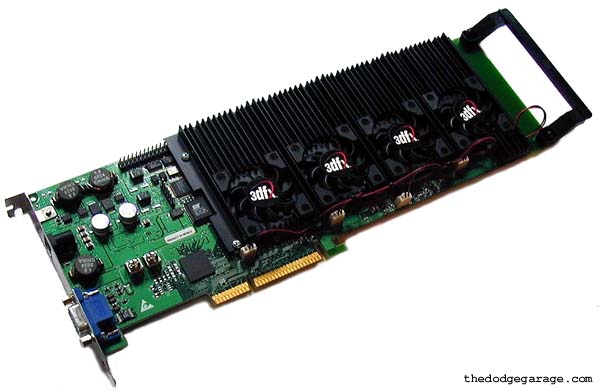
3dfx V5-6000 running at default 166-167 mhz armed with 128 mb of SDRAM. The board was then overclocked to 183 mhz to see what the effect the extra speed would have during maximum rendering stress (1024 x 768, 32 bit color and 4 x Anti-Aliasing.)
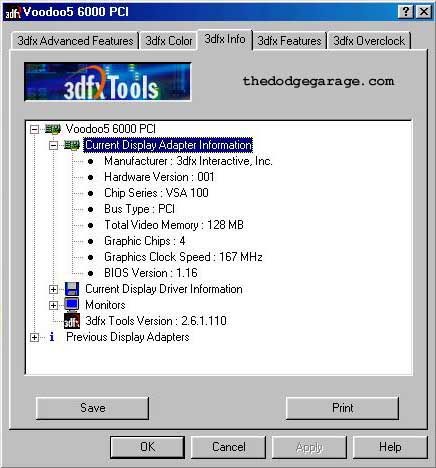
(Note the original 3dfx tools state the V6K is a PCI board, it isn't of course)
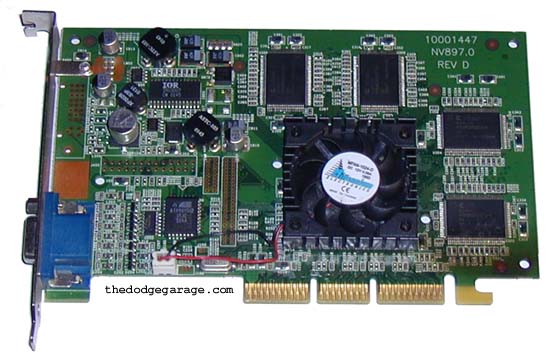
A GeForce 2 GTS-V: Equipped with 32 MB of DDR ram and normally clocked at 175 mhz core & 286 mhz ram this board was overclocked to full GTS specs (200 core/332 ram) to see what the effect the extra speed would have during maximum rendering stress (1024 x 768, 32 bit color and 4 x Anti-Aliasing.)
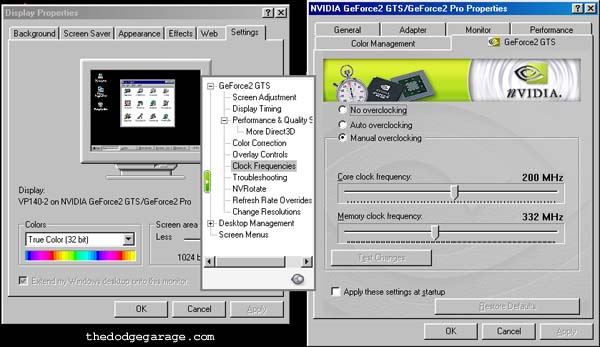
Much fanfare had been made of this card as the board that killed the V5-6000 program, would the benchmarks prove this out?
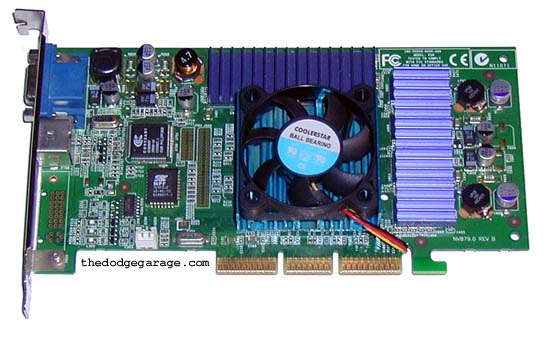
GeForce 3 clocked 200/460: With more than twice the transistor count of the GeForce 2 and 64 MB of DDR ram running at an effective 460 mhz the GF3 flexes mighty amounts of rendering muscle.
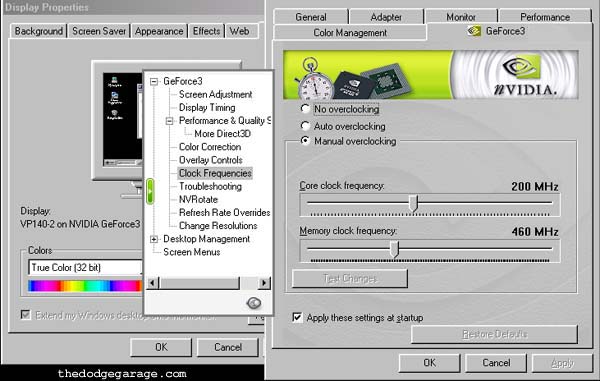
Will this later video card take top rendering honors in our grueling shootout?
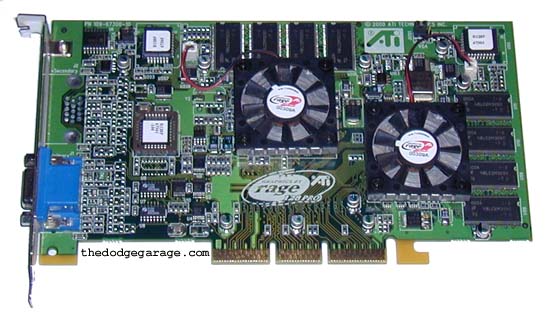
And our final contestant: The 2000 vintage ATI Rage Fury Maxx 64 MB with two ATI Rage Fury chips running at 125 mhz core and 143 mhz ram.
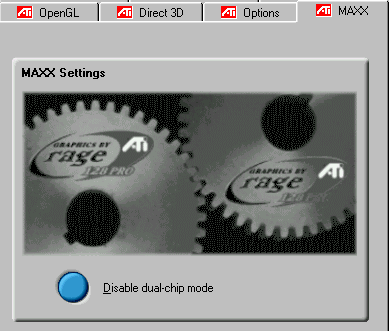
Between the slightly buggy ATI drivers and lackluster performance the Maxx board is the odd man out in this group. Even though anti-aliasing was "available" under Direct X rendering no changes in benchmarks or image quality was noted.
Testing on this board was therefore limited to 1024 x 768, 16 bit and 32 bit with no Anti Aliasing tests run.
NOTE: ATI advertises this board as having an "2x/4x AGP connector" with "2x/4x compatibility" BUT it only operates at 1x or 2x! It is NOT a 4x AGP spec compliant part aside from the mechanical ability of working in a 4x motherboard.
The Platform:
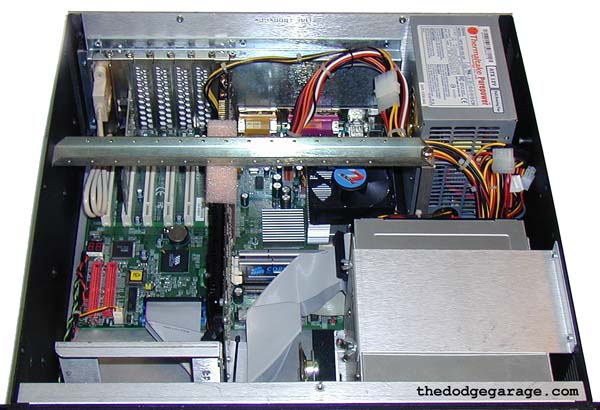
Motherboard:
Epox 8K3A+ (KT333, last modern chipset to support AGP 3.3 voltage required.)
Processor: AMD Barton 3000+
Ram:
Corsair 400DDR 512 MB.
Video:
V5-6000 3700-A with PCI rework & prototype fan assembly.
Sound: On
board 6 channel audio.
CD-ROM: 2000 vintage Sony (same as
used in Quantum3D systems)
Floppy: 2000 vintage
Sony (same as used in Quantum3D systems)
HD:
10 gig Western Digital ATA-66 with active cooling & heatsink.
NIC:
Linksys 10/100 530TX (Same as used in Quantum3D systems)
OS:
Win98SE with Direct X 9.
All tests were run at least twice to verify results and there was *no tweaking* of any kind to influence results!!! The results fall where they may.
Win98SE was used as the common OS as 3dfx reference drivers are available and no other OS drivers are available for the ATI board. Win2000pro was considered but in back to back tests performance with the only available third party drivers was notably not as good as Win98SE with reference drivers.
The V5-6000 used the last 3dfx non-beta reference drivers, the ATI board used the last available ATI Maxx driver and the GeForce boards used the Nvidia reference 61.76 drivers. I had downloaded the latest version (77) but the driver did not recognize the GeForce 2 board! So I had to use the first revision that I had on hand that worked with the board. Since it is dated December of 2004 I think it is more than current enough for our testing.
All driver settings were at defaults unless noted otherwise, program settings were adjusted so all rendering options were the same for all cards.
Sound was disabled in the BIOS, the ATI and 3dfx cards ran at 2x AGP, the GeForce boards were run at 4x.
Testing: All benchmarks were run at a minimum of 1024 x 768 x 32 bit color with ONE exception, Unreal Tournament. It was run at only 16 bit color due to the limitation of the 3dfx Glide driver. The benchmarks were all done with the baseline setting and then 2x AA followed by 4x AA.
For 2000 vintage video boards this would be a very stressful test of fill rate that will separate the men from the boys rather fast.
The Benchmarks: Quake 3, Unreal Tournament, Jedi Knight II Jedi Outcast, Serious Sam demo & Max Payne.
With the exception of Quake 3 the programs were installed and run without patching, only Q3 was running the latest patch. Max Payne was used to test Direct X performance as it has been proven to my satisfaction that 3DMark2000 and 2001SE are biased against 3dfx and ATI hardware.
Max Payne (1024x768x32)
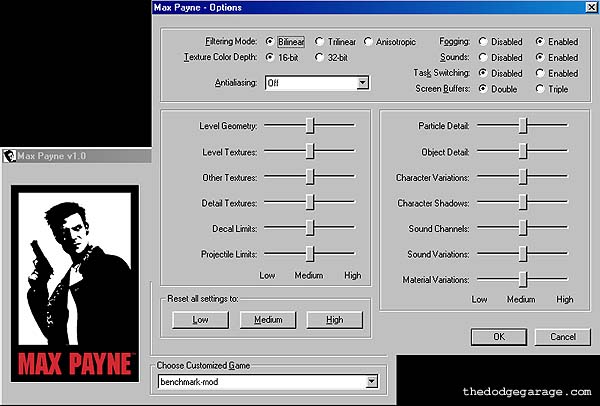
Max Payne will be our Direct X title for benchmark testing utilizing the 3D Center benchmark mod. The performance numbers might not be indicative of actual gameplay, but as a Direct X testing method I could trust it far more than 2001SE as an honest indicator of relative performance..
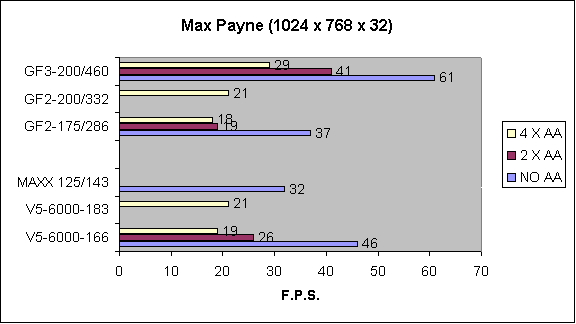
As expected with Direct X not being 3dfx's strongest rendering option, the GF3 takes a commanding lead in this intensive test. The only time the GF2 comes into a lead against the V6K is while overclocked at max rendering but in all fairness the V6K when overclocked ties the score.
So in this case it could well be argued that a GF2-Ultra (250/460 vs 200/332) was indeed faster the a V5-6000.
Serious Sam: Second Encounter - Demo Version (1024x768x32)

Benchmark methodology:
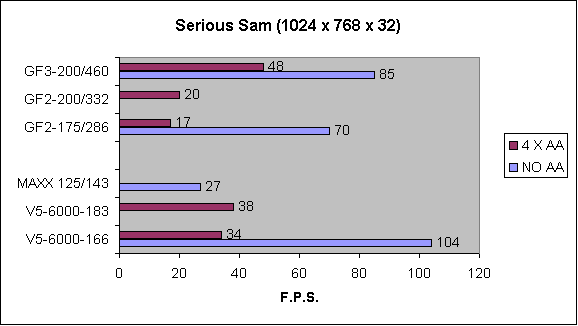
The V5-6000 would not run with 2x AA enabled for this test: A well known authority on 3dfx drivers informed me there is a bug in Glide or hardware that causes a hard lock while in 2x AA with certain alpha-blending modes. It is being investigated and if there is a fix I'll return to this benchmark and report the results.
Since there is a bug affecting the 3dfx entry, I simply skipped 2x test for all the cards and noted the results. The V5-6000 has no problem besting all contenders as a huge rout ensures in this test with one exception- The GF3 at 4x AA.
The GF3's high bandwidth powers it to the number one position at maximum stress, 1024 x 768 x 32 x 4xAA.
Unreal Tournament (1024x768x16)
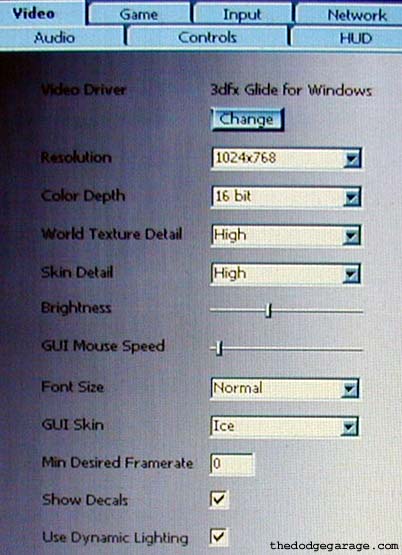
Video options for UT, of course with 3dfx card installed.
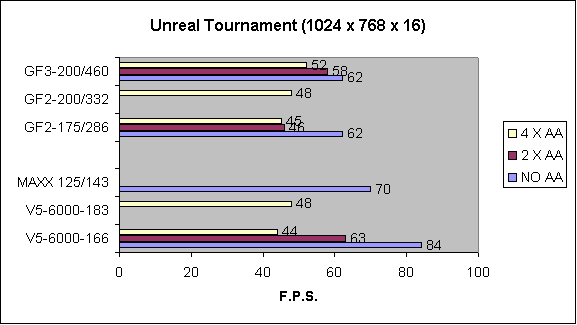
Benchmark methodology:
To run the benchmark:
Surprise of the day- The ATI Maxx pulls in a second place finish! (With no Anti Aliasing anyway) The 3dfx card runs Glide rendering while the other boards run Direct X hence the 16 bit setting for this benchmark. The V6K holds off all other boards with a very comfortable lead in no AA and 2x AA operation but when 4x AA is in operation the GF3 finally surges ahead for the win.
Quake III (1024x768x32)
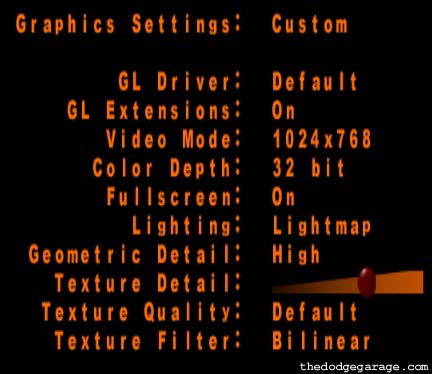
Settings under video options in Quake 3, all cards used these settings.
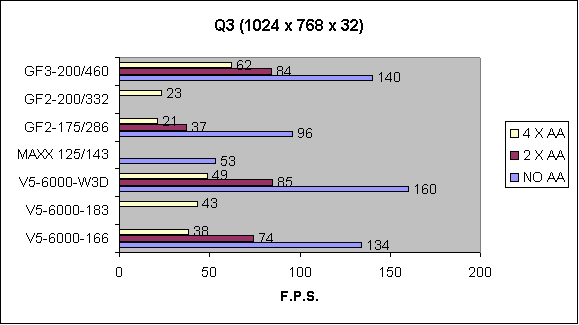
Benchmark methodology:
In this test the V6K clearly trails the later GF3 board (with exception noted below), but the GF2 doesn't even come close at any time to the quad chip V6K.
NOTE: For fun I ran a backup test of Quake 3 utilizing Metabyte's Wicked3d GL driver for 3dfx cards.
Holy upset Batman! Running at 183 mhz while cooking with the Wicked driver the V5-6000 powers it's way to the number one spot with no AA and the number 2 spot under 2x Anti-Aliasing. But alas the maximum performance spot is denied the V6K as the GF3's mighty DDR bandwidth and more efficient memory controller hands it the win.
Jedi Knight II Jedi Outcast (1024x768x32)
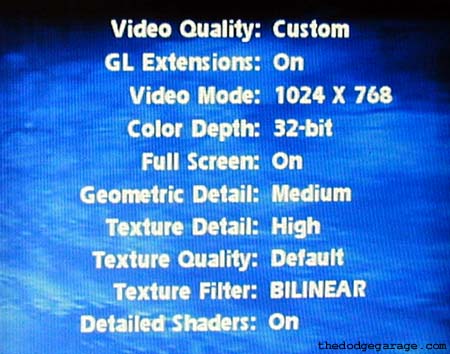
Settings under video options in Jedi Knight II, all cards used these settings.
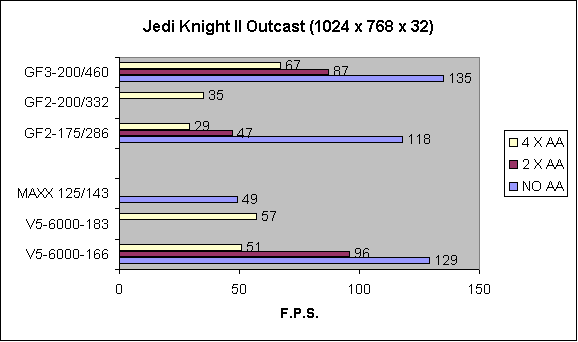
Benchmark methodology:
Odd results this time around: The GF3 wins the overall contest with the V6K breathing hard on it's heels with the 3dfx board taking the top spot with 2x rendering! Why this happened is anyone guess but there it is. The ATI board showed some really odd rendering artifacts till the texture quality was reduced to "medium" which was the setting used for all cards since the ATI board was the first tested.
Conclusion:
I'm sure some pundits will say the tests here are biased since the V5-6000 is being run on a platform that is faster than was available during the time period the card was to be released.
While this may be true to a degree, I find it hard to swallow since the same platform was used for all cards tested which levels the playing field! The numbers have been cross checked several times (indeed I swapped cards back in a few times to recheck if the results seemed odd after compiling and they remain consistent.)
On the other hand, a weaker CPU *would* penalize the V6K and ATI boards since both lack a dedicated hardware engine like the Geforce series. One has to marvel at how fast the V6K still is with such a handicap! Imagine a V6K with a Transformation and Lighting chip on board to handle geometry & lighting calculations instead of handing them off to the host CPU which saps processor cycles!!
Clearly with the GF3 release looming in mid-2001 the V5-6000 was starting to look less and less desirable for 3dfx to release. Continuing problems with the PCB design were still not rectified even as late as December 2000, and with a best case release date of first quarter 2001 things must have looked grim for 3dfx management. *IF* the V5-6000 had been released first or second quarter *2000* as planned the video graphics landscape would have looked a bit different.